Is DAO the next big thing in crypto and beyond?
We present a big picture of the DAOs (Decentralized Autonomous Organizations) and explain why they could be a central pillar for future social coordination. We also discuss the process of forming a DAO and the challenges ahead in this space.

Why should we even care about DAO?
Most people who bought crypto like Bitcoin would know Coinbase. Only a tiny portion of them might have heard about Uniswap. Both Coinbase and Uniswap offer crypto exchange services. According to Tim Fries's article in the Tokenist, amid a big crypto price crash on June 5th, 2021, Coinbase processed a trading volume of $1B while Uniswap did $0.8B. Amazingly, Uniwap sustained about 80% as large trading volume as Coinbase's on that day - with only 1/33 the number of personnel.
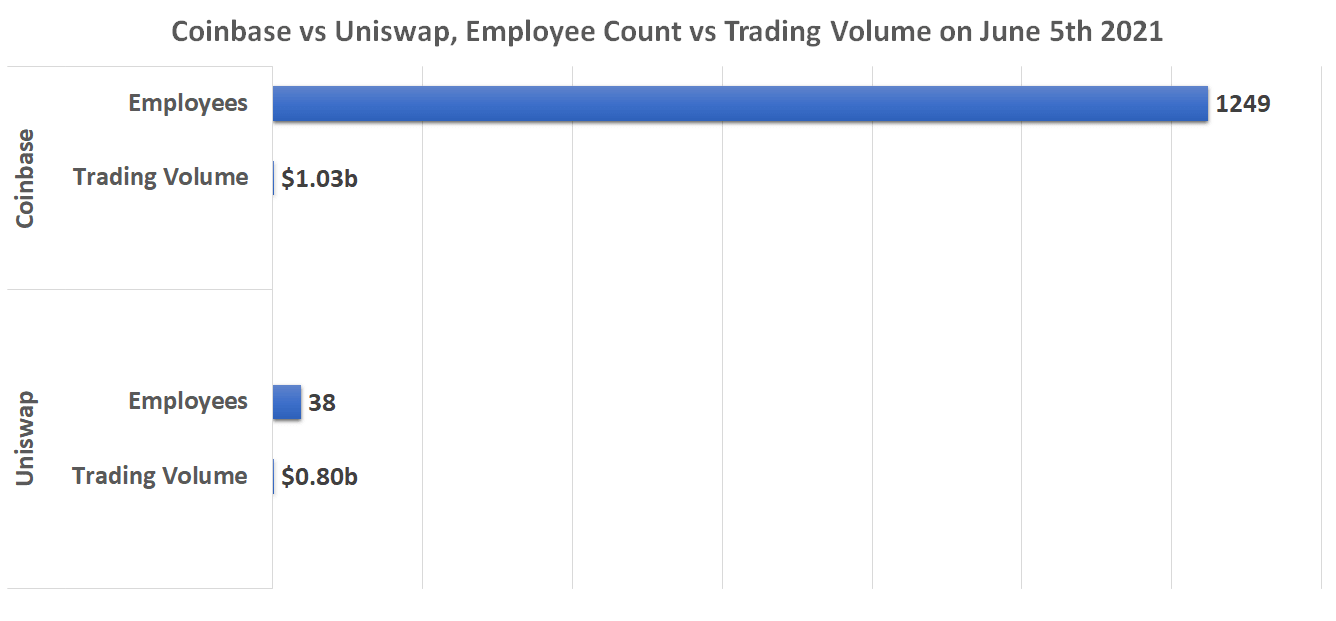
So what are the differences between these two entities? A quick answer is that Coinbase's structure is a corporation with which we are all familiar. Uniswap, on the other hand, is a DAO - Decentralized Autonomous Organization, which is a new organizational structure for the emerging Web 3.0 era. The comparison of the operational effectiveness in this particular situation is by no means scientifically accurate because of differences in many other factors, such as regulatory compliance implications. However, it does offer a compelling peek into the potential impact a DAO could bring to us.
Ali Yahya of A16Z talked about an exciting analogy that compares DAO vs. corporations as the Internet vs. postal mail service. The point is that both the Internet and the postal mail service are essentially delivery services (for packets vs. packages). There are plenty of reasons to believe the Internet way of delivery is 10,000 times better than the post mail way of delivery. More importantly, the delivery service is a universal infrastructure in human society. A 10,000 times improvement of such an infrastructure enabled an astronomical amount of innovations on top of it, including all the FAANG (Meta, Amazon, Apple, Netflix, Google) and other Internet-related companies.
While far from clear at this time, the potential also exists for DAO to advance social coordination and organization by 10,000 times over today's business corporation mechanisms. Given how ubiquitous businesses and corporations are in our society, social coordination and organization are also universal infrastructures. What will be the explosive innovations born out of this transformation in the social coordination space? Will they produce a profound impact on human society as the Internet delivery service has brought to us? We do not have the answers yet, but that is precisely why we should understand DAO and be better prepared.
What is a DAO, then?
DAO provides a new way of forming organizations. Organizations are entities through which people can coordinate and work together to achieve goals that are impossible individually. The power of organizations has been a fundamental force propelling society's advancement throughout our history.
Today's organization works by establishing standard rules and letting their members follow them to carry out collaborative activities. In the example of a company, its founders could initially set up its mission (e.g., producing a specific product or service to serve targeted customers). There is a Board of Directors and executive team who make ongoing management decisions. The management team recruits additional people to the company and helps execute the mission. One important characteristic here is the dependence on a small group of decision-makers for governance. Therefore it is a typical centralized, top-down model.
Amid the backdrop of the decentralization movement initiated by Bitcoin tackling financial services, DAO can be considered the counterpart that aims to decentralize organization management. Specifically, blockchain smart contracts enable the automatic execution of rules without human intervention. Akin to how smart contracts replace financial institution intermediaries in Decentralized Finance (DeFi), smart contracts may also substitute an organization's centralized human management body. That paves the way for the organization to become a DAO. In other words, we still have the rules of an organization. But instead of them being enforced by a group of central authorities, the rules are coded into a computer language interpretable by the blockchain and automatically executed by the blockchain.
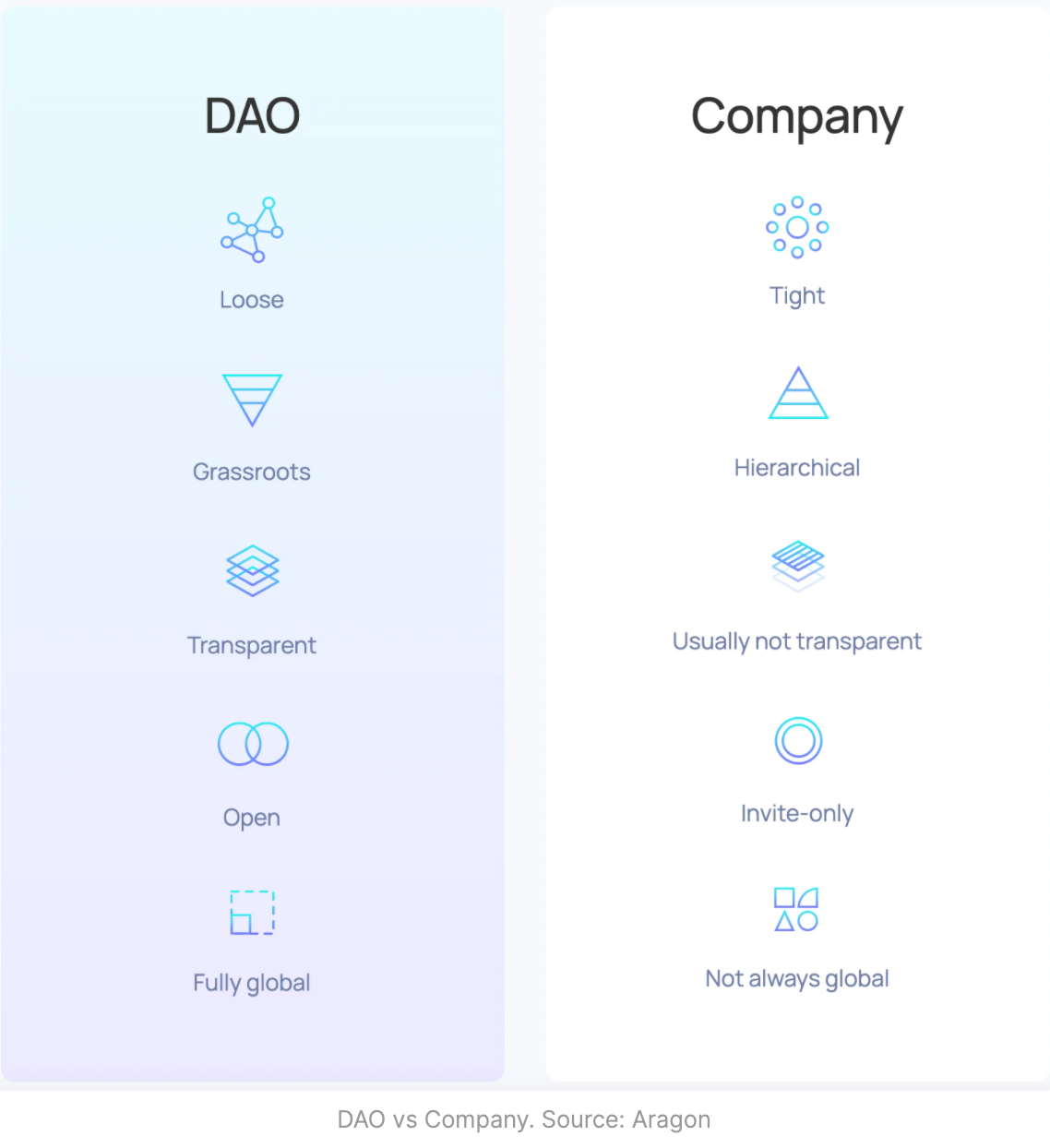
The impact of DAO could be far more profound than it might appear to be, as illustrated in Figure 2 by Aragon. A DAO is a grassroots initiative that anyone can start and does not have a top-down hierarchy. It is inclusive and open for everyone to participate, rather than being limited by various human and geographical constraints.
Furthermore, the rules of the DAO are all coded in smart contracts and open source for anyone to examine. What this organization will do and in what circumstances is fully transparent to the entire world. Because of that, a key difference from the corporations is that the DAO does not have a small group of central executives making decisions. All decisions are typically made through grassroots voting of all DAO members. In this way, the DAO members truly own and run the DAO themselves.
All benefits do not come for free, however. There are also new types of risks for the DAO. For example, when the DAO's smart contracts code knowingly or unknowingly contains bugs, it becomes vulnerable to hackers. Even in those cases, people can still thoroughly understand what the issue is based on the open-source code and therefore can better come up with counter-measures, as we will see in an example from the next section.
What are examples of DAOs?
A central coordination task in an organization is managing its treasury and allocating funds to achieve the organization's mission. One of the earliest and most famous DAOs does exactly that, and it is called "The DAO", launched on the Ethereum blockchain in 2016. "The DAO" aims to create a decentralized venture capital fund by crowdsourcing capital from its members. It was able to amass almost 14% of the ETH supply at that time, worth over $140M. Yet the fund is completely governed by a smart contract, which takes votes from its members to decide whether and how to invest in startup companies curated by a group of volunteers. Unfortunately, hackers exploited bugs in "The DAO"'s smart contract shortly after it had been launched and stole $50M of the fund. This is a perfect example of the new type of risk in the DAO when no human intermediary is involved. Since the code was open source, the community managed to understand what had caused the situation precisely. Eventually, it was able to recover all the funds, even though via controversial means.
The "The DAO" incident no doubt left a dent in the early history of the DAO. However, fast forward five years to 2021, and the DAO space is more than flourishing. One of the most recent DAOs that hit the mainstream media is called ConstitutionDAO. As a single-purpose DAO set up to bid for one of the 13 surviving copies of the original print of the US Constitution, ConstitutionDAO is able to raise over $40 million worth of ETH in less than a week from investors all over the world. While eventually losing the bid to a long-term Wall Street established figure, the ConstitutionDAO has become a unique episode in the recent history of DAO.
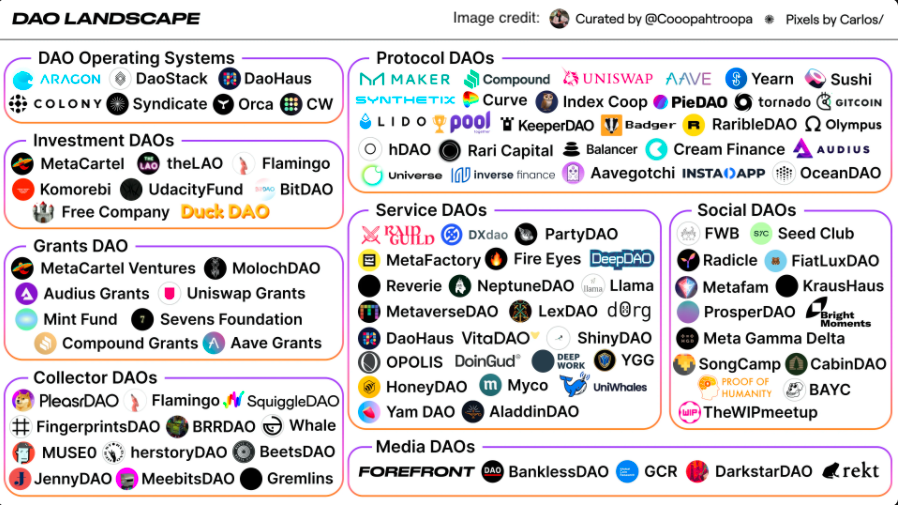
Figure 3 by @Coopathroopa and Carlos gives a great big picture of the current DAO landscape classified into different purposes.
- Protocol DAOs are a significant category that includes most DeFi services, ranging from decentralized exchanges, banks, and credit institutions to Oracle Services and more.
- Investment DAOs and Grants DAOs are both for funding various projects in the Web 3.0 space, either as venture investments or as grants. This type of funding has been a strong driver for the prosperity of the crypto and blockchain ecosystems.
- Collector DAOs are formed to collect NFT digital arts and other collectibles. PleasrDAO, e.g., targets unique pieces which carry potent messages that transcend crypto. It is also experimenting with shared art ownership and other innovations to create value for the community.
- Social DAOs are an interesting category in that they provide a certain social circle for their members. The Bored Apes Yacht Club (BAYC) is among the most famous ones. Its members need to hold a limited NFT collection, and the club provides various services and utilities for its members both in the physical world and the virtual lands of the metaverse.
- Media DAOs are like news media organizations. BanklessDAO, for example, provides excellent resources to onboard people into DeFi and Web 3.0.
- While essentially all DAOs are service-driven, Service DAOs are the ones that provide services not covered by the above categories. For instance, Yield Guild Games (YGG) DAO is a "play-to-earn gaming guild". They invest in NFTs in the virtual world and lend them to players, helping them earn real-life income by participating in metaverse economies.
- Finally, DAO operating systems are the infrastructure piece of DAOs that provides technology tools to support the DAO operations. While most of them are intended for generic DAOs, some are more focused. For example, Syndicate aims to create an investment plus social network platform to transform today's venture investing syndicate model.
How to form a DAO: part I - the community
The community is the foundation of any DAO.
Bootstrap a community from scratch
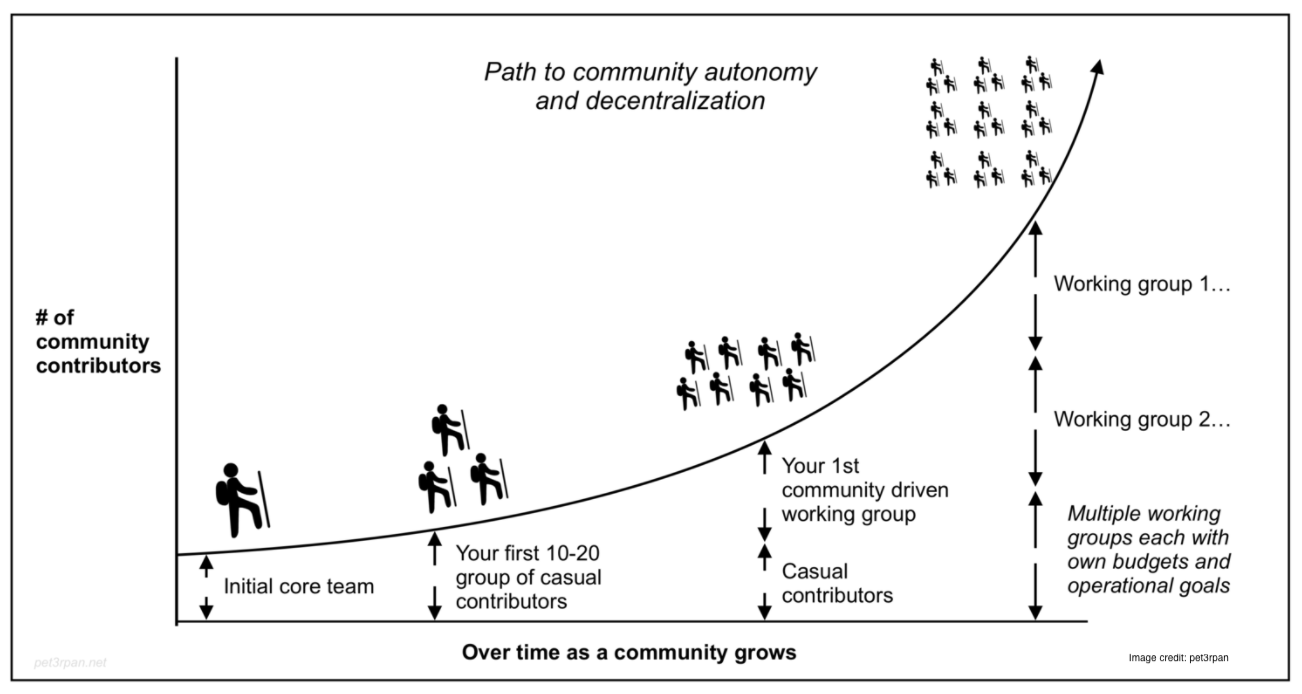
Building a community from scratch is not easy. As Figure 4 shows, it starts from a few core team members with a mission and vision. They then attract the initial dozens of early contributors. As time goes on, more people join and spin off the 1st community-driven working group. As the organization continues to grow, more specialized working groups are likely to be created. Eventually, the community may organically grow to have working groups covering all aspects of a well-functioning organization. In the example illustration of Figure 5 from 1kx fund, these sections could include Treasury, Product, Engineering, People, Community, PR/Marketing, and Business Development.
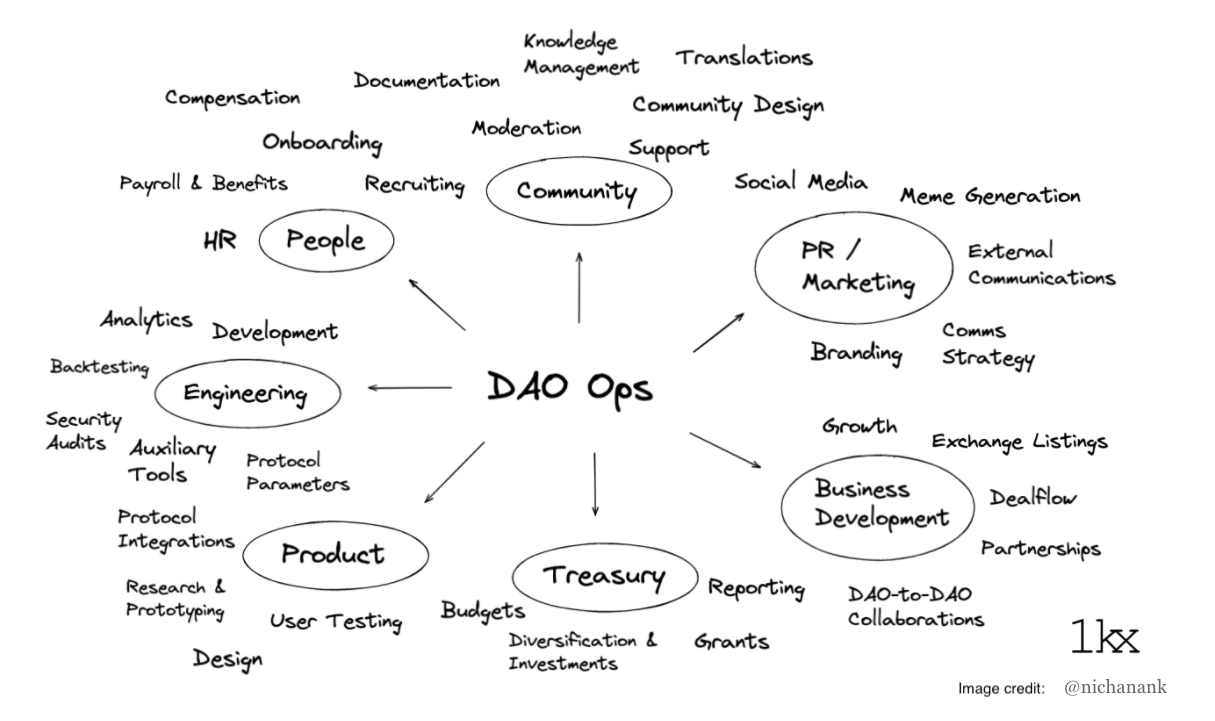
Convert an existing community
It is fair to say that most, if not all, successful crypto projects have strong community support, whether the project is related to DeFi, NFT, gaming, or other themes. Many of their communities did not start as DAOs from the very beginning. Instead, they employ a centralized management model when bootstrapping their community. This option could present some advantages in the early stage of the project when the team needs to make decisions and iterate the product and services quickly. However, when the project matures to a particular stage, the management team may decentralize it and convert it to a DAO. This essentially passes the ownership and decision-making of the organization from the hands of the top few to all members of the community.
A landmark example of an existing community converting to DAO is the case of Compound Protocol. Compound is a DeFi provider known for lending and borrowing services. In June 2020, The Compound management team gave up control of the protocol and issued a governance token to all its stakeholders. Since then, Compound has been owned and managed by its governance token holders through blockchain smart contracts. Furthermore, numerous other protocols and projects in the Web 3.0 space have either followed suit to convert to DAOs or started the community as a DAO from their onset!
How to form a DAO: part II - the infrastructure
With the community already formed, the other primary component of the DAO is the technology infrastructure that enables its operation. Many tools cover a diverse set of DAO operations exist, as illustrated in Figure 6 below by 1kx fund:
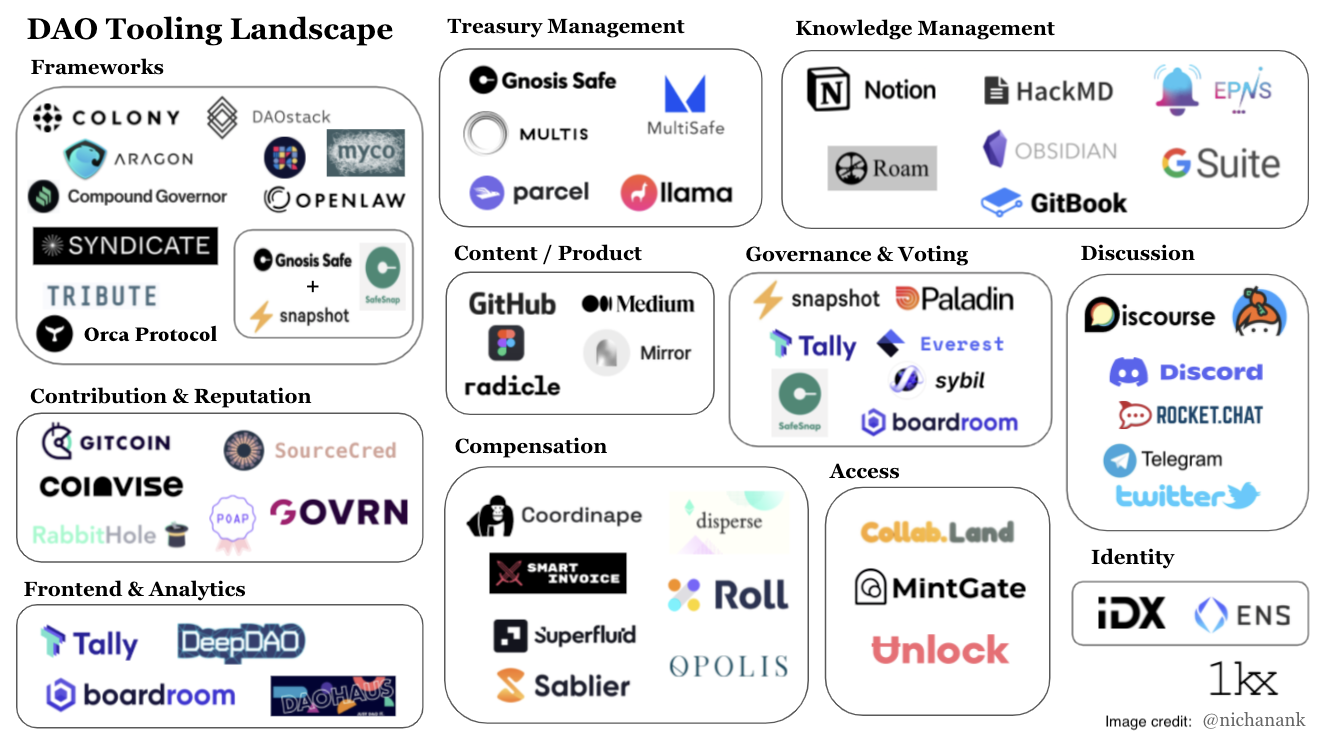
DAO frameworks provide technology tools for creating DAOs. A DAO can be created using turnkey solutions that integrate essential functionalities, such as Aragon, Colony, and DAOstack; or it can pick and choose from individual solutions for each functional component and combine them for operation. There is a rich list of tools that cover all the different functionalities of DAO. In a sense, each of these pieces is like lego bricks and the DAO is the final castle built from these bricks. This is similar to the money lego known in DeFi, except that we have social coordination/organization lego here!
To illustrate, we can consider building a basic DAO for Web 3.0 education using the lego method. The initial core team can start by setting up a Discord server for members to engage in discussions, such as what members want to learn and who can contribute the learning materials. Next, it can distribute the DAO-specific tokens to its members and also create a profile on Ethereal Naming Service (ENS) ENS is a blockchain counterpart of the Internet's Domain Name Service (DNS). When governance decisions need to be made, e.g., what learning modules are to be offered and in which timeline, it can use Snapshot to conduct the voting process and determine the results. The DAO's treasury can be built up in various ways, such as grant funding, token sale, or member dues. The funds can be managed by Gnosis Safe. To compensate members working for the DAO, e.g., those who contribute modules or lead the course instructions, the DAO can leverage Coordinape to handle reward allocation. Coordinape provides a novel mechanism that allows peer contributors, in this case, learners and instructors, rather than the management (which is technically non-existent in a DAO anyway) to decide how much compensation should be awarded to each member of the DAO.
Challenges of DAO
DAO is still in its very early stage, and there are plenty of challenges ahead of us toward realizing its grand vision. Some of them are as follows:
- How to lower the barrier of onboarding and engage more of the non-crypto native, non-developer population into DAOs. Since a full-fledged DAO requires almost all domain experts as in traditional companies, it needs to offer an easily accessible user interface and experience to attract those people. Today's DAO interface and experience are still intimidating for most people not already in the crypto world.
- What is the best-decentralized governance structure within a DAO? While today's DAO governance by default uses a flat voting method based on the number of governance tokens (coins) owned, its drawbacks are becoming increasingly apparent. For this vital topic, Ethereum co-founder Vitalic Buterin has a specific post on why we should consider "Moving beyond coin voting governance". A related issue is a balance between a completely flat structure vs. a delegation model where people who prefer not to be involved in the governance can delegate their votes to other appropriate members.
- The development in the DAO tooling space is far from mature. Some of the pressing issues include, for instance, how to appropriately measure and compensate for the different types of contributions from each member. How to coordinate on-chain (on the blockchain) and off-chain management effectively?
- Security of the DAO. Even though DAO removed the centralized human intermediary and its associated risks, it does introduce its own risk category, such as smart contract risks. The security of smart contracts is a very active research area within the blockchain industry since they are at the core of most blockchain-based services.
- The legal and regulatory status of DAO is yet to be clarified. As of late 2021, Wyoming is the only state in the US that recognizes DAOs as a legal entity.
Summary and Challenges
DAO is characterized by a novel organizational structure. It replaces today's human-based centralized organization management with computer code, specifically, blockchain-based smart contracts that can automatically execute the organization's rules. It enables much more open, inclusive, and grassroots social coordination. Its fully transparent and decentralized governance allows each member to truly own and run their organization.
DAO is not just the next buzzword in crypto after DeFi and NFT. Instead, it could be at the center of any successful crypto project, which is almost always associated with a strong community. The power of DAOs we have seen today is merely the tip of the iceberg. The crypto and blockchain community expects DAO to eventually become the 10,000x booster to transform the entire social coordination infrastructure, similar to how the Internet has changed the foundational postal mail delivery system.
However, it is equally important to remember that we are still in the infancy stage of DAO. The barrier of onboarding, decentralized governance, and many aspects of tooling, security, and legal and regulatory clarity are just some of the challenges we have to conquer towards its ultimate vision.
Note: this article is part of my Introduction to Blockchain, Crypto, Metaverse and Web3: Beyond the Hype. You may find the rest of the articles in the series here.
